 France 1859-1908, Broadside Ironclad
France 1859-1908, Broadside IroncladMarine Nationale's Ironclads
Gloire class | Couronne Bd. Ironclad | Magenta class Bd. Ironclads | Arrogante class Flt. Batteries | Provence class | Embuscade class | Palestro class Flt. Batteries | Taureau | Belliqueuse Bd. | Ocean class | Alma classThe French ironclad Couronne (“Crown”) was the first iron-hulled ironclad warship built for the then French Imperial Navy in 1859–1862. She was the world’s first to be laid down, albeit HMS Warrior was completed first. She took part in the Franco-Prussian War of 1870–1871 in a limited way combat. She eventually ended as a gunnery training ship from 1885, completely rebuilt and dramatically changing appearance, until 1908 when she was hulked and became a barracks ship in Toulon and eventually scrapped… in 1934, 70 years after she was completed. Unfortunately unlike warrior she was not preserved.
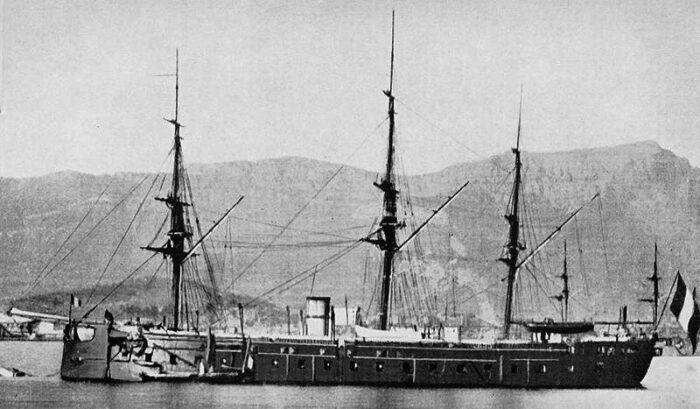
Couronne at the start of her career in 1963
Design of the class
Couronne was designed by the French naval architect Camille Audenet, from a 1858 proposal by Dupuy de Lome to Napoléon III. She was to be the world’s first iron-hulled armoured frigate, on a parallel development of the Gloire-class ironclads, and not a sister ship. She was to be unique due to her cost and even more experimental nature, but she was intended to lead a battle line unlike most concepts of ironclads frigates at the time, created for independent actions. She was still classified herself as an armoured frigate with just a single gun deck on a broadside. The hull still resembled Gloire’s and she also shared protection caracteristics such as a conning tower.
Hull and general design
Couronne ship was larger than Gloire and her sister at 80.85 metres (265 ft 3 in) long overall, at the tip of her ram. Her beam was the same as 17 metres (55 ft 9 in) and her maximum draft was lower at 7.8 metres (25 ft 7 in), still with a hold depth of 9.7 metres (31 ft 10 in). This made on paper for a slender hull, better suited for speed, but the lower draught meant potential stability issues. She displaced 6,428 tonnes (6,326 long tons) so substantially more than Gloire (5,618 t). Despite her lower draught, her metacentric height was suprisingly good, at 1.8 metres (6 ft). In fact she proved more stable and rolled les while being a better sea boat compared the Gloires. Her other advantage was to have gun ports slightly higher above the waterline (2 metres (6 ft 7 in)) and better out of water spray in heavy weather. Her crew was of 570 officers and enlisted men. Camille Audenet created a winner, yet she was still smaller and slower than her direct opposition, HMS Warrior.
Powerplant
Courinne was powered by a single propeller shaft, six-bladed, 5.8-meter (19 ft) driven by a Mazeline horizontal return connecting-rod compound steam engine (HRCR) provided steam provided from eight Indret (4x ports each, 32 total) oval boilers. Her designed speed was 12.5 knots (23.2 km/h; 14.4 mph) from 2,000 up to 3,200 indicated horsepower (1,500 to 2,400 kW) according to numerous contradictiry sources. On French source claims 900 hp per cylinder (bore 2.08 m; stroke 1.27 m), 2900 hp total. Her sea trials however registered 13 knots (24 km/h; 15 mph) out of 2,597 metric horsepower (1,910 kW) so her normal output could be around 2,400 ihp. This engine was fed with a total of 675 tonnes (664 long tons) of coal in normal load, enough to steam gea way over 2,410 nautical miles (4,460 km; 2,770 mi) at 10 knots (19 km/h; 12 mph) which was better suite for the Mediterranean.
Her sailing rig was a full barque, with square rig on three mast at first. Its was surestimated 27.000 sq. foote instead of 11.800 sq. ft. standard. Later she was refitted with a light barquentine rig on three masts but this was the object of multiple changes during her career as she still carried a new barque rig in the late 1880s as gunnery TS.
Protection
Couronne had a fully armored wrought iron hull protected by 120 millimetres thick armour plates all along. This was sufficient to completly stop any standard solid shots of the time. Despite she was iron-hulled, her armour backing like for the Gloire consisted of two layers of teak wood over 380 millimetres (15 in), but intertwined with an iron lattice work just 33 millimetres (1.3 in) thick, and anoteher inner protective layer of 20-millimetre (0.79 in) to protect the crew from shrapnel. Like the Gloire she had a forward conning tower with a wheel and repeaters, protected by 100 millimetres (3.9 in) of plate. She also had a protected weather deck, 12.7 mm (0.5 in) of underneath the wooden upper deck for possible lobbing shots.
The deck was in fact made of 10 cm teak covered with 1.25 cm thick iron sheets. The main structural beams were made of iron. The prow was reinforced to allow ramming and the glanks for boarding, and to limit the extent of the damage suffered in a ramming, transverse watertight bulkhead was placed 6.5 m from the bow. The overall weight of the entire protection system was 1,600 t.
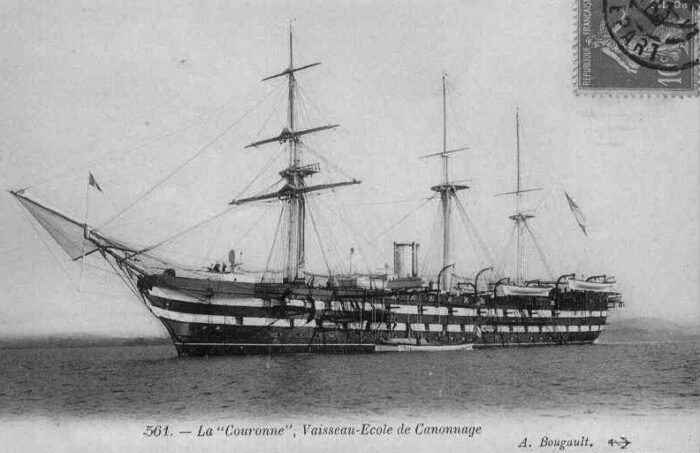
Couronne by Bougault, late appearance as a gunnery training ship
Armament
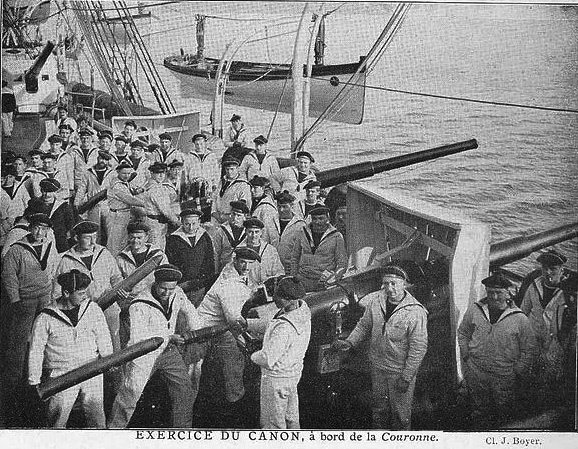
Couronne was armed with a classic broadside of thirty six Modèle 1860 164.7-millimetre (6.5 in) rifled breech-loading guns. Thirthy were locared on the broadside, fifteen per side, and remaining four on the upper deck as chase guns with a turning table and furing fore and aft to about 90° in their respective angles. They fired a 44.9-kilogram (99.0 lb) shell at 322 metres per second (1,060 ft/s) but this was ineffective against armour.
She was rearmed multiple times.
1864: Chase guns replaced by four 220 mm (8.7 in) howitzers and broadside by improved Modèle 1864 guns. These Canon de 19 C modèle 1864 were rebored to 194-millimetre (7.6 in) on her main deck and there were six 164.7 mm guns on the upper deck as chase guns. Another source precises she had tewnty 160 mm rifled (mod 1860) and sixteen 50 mm smoothbore on the upper deck, four 160 mm rifled guns being later changed for four 80 mm explosive shells howitzers.
1869: Her main battery comprised now eight 24cm guns modèle 1870 (9.4 in) and four 194 mm on her forecastle.
1881: As gunnery training ship (completed 1885) she had the following:
Same eight Canon de 24 C modèle 1870 (9.4 in) guns in the battery deck
Same eight 194 mm Modèle 1870 guns on the main battery deck.
Then three 240 mm, three 194 mm, three 164 mm on the battery deck, sixteen 14 cm on upper battery and three 100mm forecastle.
1885 and beyond: Addition of two 120 mm (4.7 in) guns, upper deck, shielded.
Twelve 37 mm (1.5 in) 5-barrelled Hotchkiss revolving cannon, upper deck.
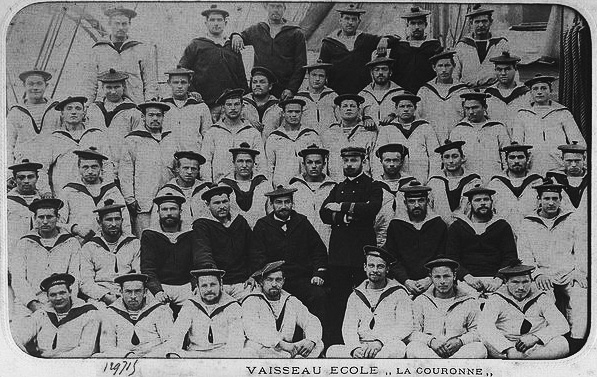
⚙ Couronne specifications |
|
| Displacement | 6,428 t (6,326 long tons) |
| Dimensions | 80.85 x 16.7 x 7.8 m (265 ft 3 in x 54 ft 9 in x 25 ft 7 in) |
| Depth of hold | 9.7 m (31 ft 10 in) |
| Propulsion | 1 shaft HRCR-steam engine, 8 oval boilers: 2,597 PS (1,910 kW) |
| Sail plan | Barquentine rigged |
| Speed | 12.5 knots (23.2 km/h; 14.4 mph) |
| Range | 2,410 nautical miles (4,460 km; 2,770 mi) at 10 knots (19 km/h; 12 mph) |
| Armament | 30 × 164.7 mm (6.5 in) rifled breech-loading guns |
| Protection | Belt 120 mm (4.7 in), CT 100 mm (3.9 in), deck 12.7 mm (0.5 in) |
| Crew | 570 |
Career of Couronne
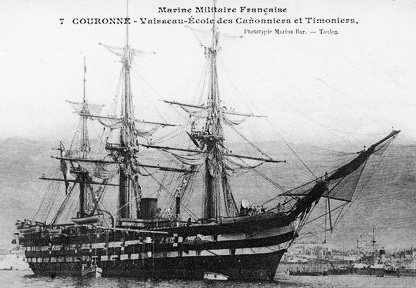 Couronne was ordered on 4 March 1858, laid down at the Arsenal de Lorient (Atlantic coast) on 14 February 1859. She was launched on 28 March 1861 and commissioned on 2 February 1862 at a cost of 6,018,885 francs. She was the costiest French warship ever built.
Couronne was ordered on 4 March 1858, laid down at the Arsenal de Lorient (Atlantic coast) on 14 February 1859. She was launched on 28 March 1861 and commissioned on 2 February 1862 at a cost of 6,018,885 francs. She was the costiest French warship ever built.
On 22-7-1862 she was placed in the 1st reserve at Cherbourg.
On 19 June 1864, she was present during the Battle of Cherbourg, escorting the Confederate commerce raider CSS Alabama out of French territorial waters to ensure she left these and not violate French neutrality when offered a challenge by USS Kearsarge.
Later she was assigned to the Mediterranean Fleet, but went back to Brest in August 1865 as the whle Marine Nationale hosted the British Channel Fleet. A few days later the she was part of the reciprocal visit to Portsmouth, hosted by the Channel Fleet.
Before this, in May she took part in the naval review of Marseille, before escorting Napoleon III’s yacht to Algeria.
On 17 January 1867 there was an adjustment of the compasses at the anchorage of the four chests in Toulon.
On 1 March 1867, Couronne was grounded ina storm at Hyères island in off Var, having several sailors lost in that event. She was later freed with some help and repaired.
On 24 feb. 1869 she is rearmed in Toulon and on 30 August she is back to Toulon after manoeuvers off Ajaccio with the squadron.
In the start of 1870 she is part of the “flotilla of Paris”.
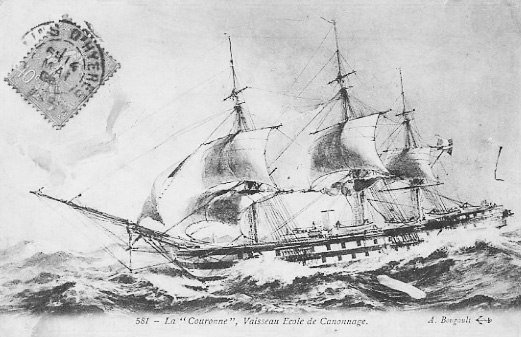
By June 1870 she was in Oran. During the Franco-Prussian War of 1870 she was assigned to Vice Admiral Léon Martin Fourichon. His squadron was ordered to blockade German ports in the Heligoland Bight between August and September 1870. The problem was there was no way to supply these in coal, Denmark and britain remaining neutral. The four German ironclads sortied from Wilhelmshaven sortied in search but went back as the French squadron only returned from coaling by mid-September before being forced to abandon the blockade again for the same reason. No plans had been made prewar to have them recoal at sea. The fleet pretty useless in this war, which ended on land (badly for France). Couronne was sent back to Toulon on 10 December and given the postwar austerity, rarely sortied.
On 13 January 1871 she sortied from Toulon to the Gulf of Juan for exercises, and on 15 March she was sent from Villefranche harbor to Marseille, to prevent riots among dockers.
By May 1876 she made a training cruise with the 2nd division, evolution squadron, and divereted to Salonika, Greece, after the assassination of the French and German consuls. In 1877-78 she is bacl with the evolution squadron, Mediterranean fleet.
From 1881 to 1885, she was completely reconstructed as a gunnery training ship, replacing in this role the old Souverain. She was completely stripped of armour, replaced by wood of the same thickness, two of her boilers were removed, her propeller was replaced by a more modern model. Her simplified schooner rigging was replaced by a full barque rig again whereas an iron spar deck and poop decks were fitted with a brand new prow, giving her, with new painting, the appearance of a classic Napoleonian steam ship of the line. She was quite elegant but no longer relevant as warship, albeit rearmed twice with a collection of ordnance recentky introduced on the French Navy.
The plans had been drawn by the engineer Cousin of Toulon NyD. She also had a spardeck made of light iron and a new poop deck added. Her final output was 600 hp and her new propeller was of the “Mangin” type.
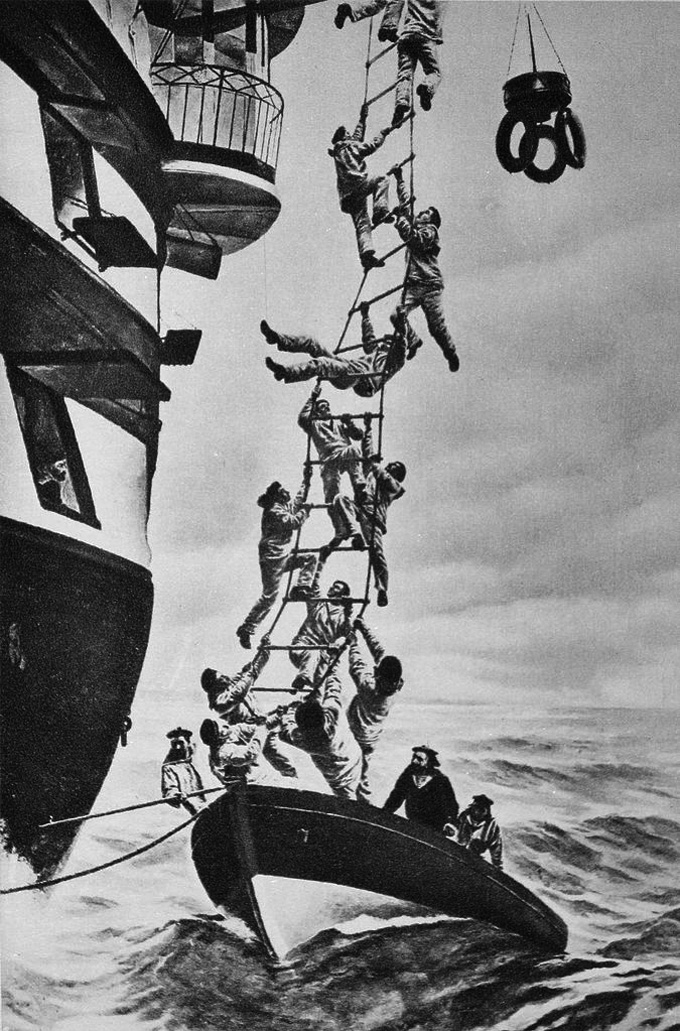
This assortment of guns of various calibres was for training purposes and she had extra accomodations for her crew and extra trainees for a grand total of 1,200 officers and enlisted men. She held that rile until replaced in turn as gunnery training ship on 1 December 1908, disarmed on 1 September 1909. Her hull being in good conditions she was hulked (stripped of everything, masts included, her upper deck covered) and became a floating barracks at Toulon until sold on 25 October 1933 to Mr. Bonturi for 226,100 Francs. In 1934 she demolition is completed. She saw the fall of Napoleon and the last French Empire, a monarchy, three Republics and WWI.
Read More/Src
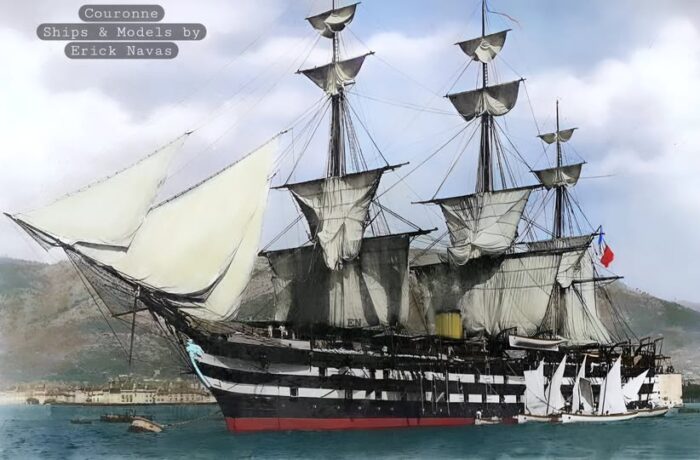
Couronne as 1885 TS, rendition by Erick Navas src
Books
De Balincourt, Captain; Vincent-Bréchignac, Captain (1974). “The French Navy of Yesterday: Ironclad Frigates, Part I”. F.P.D.S. Newsletter.
Campbell, N. J. M. (1979). “France”. In Chesneau, Roger & Kolesnik, Eugene M. (eds.). Conway’s All the World’s Fighting Ships 1860–1905.
Gardiner, Robert, ed. (1992). Steam, Steel and Shellfire: The Steam Warship 1815–1905. Conway’s History of the Ship. London: Conway Maritime Press.
Gille, Eric (1999). Cent ans de cuirassés français [A Century of French Battleships] (in French). Nantes: Marines.
Jones, Colin (1996). “Entente Cordiale, 1865”. In McLean, David & Preston, Antony (eds.). Warship 1996. London: Conway Maritime Press.
Luraghi, Raimondo (1996). A History of the Confederate Navy. Annapolis, Maryland: Naval Institute Press.
Roberts, Stephen S. (2021). French Warships in the Age of Steam 1859–1914: Design, Construction, Careers and Fates. Barnsley, UK: Seaforth Publishing.
Silverstone, Paul H. (1984). Directory of the World’s Capital Ships. New York: Hippocrene Books.
Sondhaus, Lawrence (2001). Naval Warfare, 1815–1914. London: Routledge.
Wilson, H. W. (1896). Ironclads in Action: A Sketch of Naval Warfare From 1855 to 1895. Vol. 1 and 2. Boston: Little, Brown.
Links
on navypedia.org/
en.wikipedia.org/ French_ironclad_Couronne
forum.pages14-18.com
on postedeschoufs.com
on dossiersmarine.fr/f_fc.htm
fr.wikipedia.org
Model Kits
None. The galleon/ship of the line had more success.

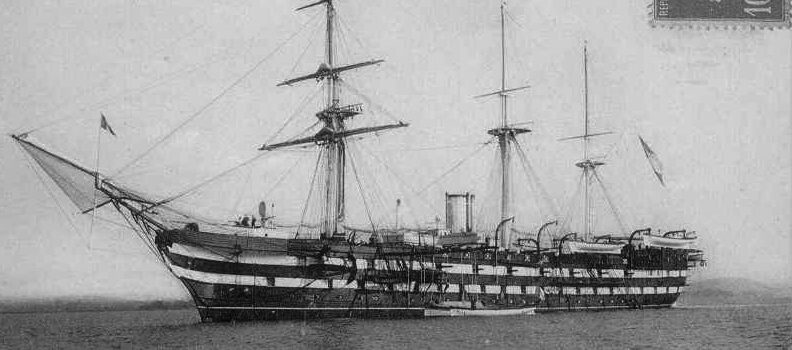
 Latest Facebook Entry -
Latest Facebook Entry -  X(Tweeter) Naval Encyclopedia's deck archive
X(Tweeter) Naval Encyclopedia's deck archive Instagram (@navalencyc)
Instagram (@navalencyc)





 French Navy
French Navy Royal Navy
Royal Navy Russian Navy
Russian Navy Armada Espanola
Armada Espanola Austrian Navy
Austrian Navy K.u.K. Kriegsmarine
K.u.K. Kriegsmarine Dansk Marine
Dansk Marine Nautiko Hellenon
Nautiko Hellenon Koninklije Marine 1870
Koninklije Marine 1870 Marinha do Brasil
Marinha do Brasil Osmanlı Donanması
Osmanlı Donanması Marina Do Peru
Marina Do Peru Marinha do Portugal
Marinha do Portugal Regia Marina 1870
Regia Marina 1870 Nihhon Kaigun 1870
Nihhon Kaigun 1870 Preußische Marine 1870
Preußische Marine 1870 Russkiy Flot 1870
Russkiy Flot 1870 Svenska marinen
Svenska marinen Søværnet
Søværnet Union Navy
Union Navy Confederate Navy
Confederate Navy Armada de Argentina
Armada de Argentina Imperial Chinese Navy
Imperial Chinese Navy Marinha do Portugal
Marinha do Portugal Mexico
Mexico Kaiserliche Marine
Kaiserliche Marine 1898 US Navy
1898 US Navy Sovietskiy Flot
Sovietskiy Flot Royal Canadian Navy
Royal Canadian Navy Royal Australian Navy
Royal Australian Navy RNZN Fleet
RNZN Fleet Chinese Navy 1937
Chinese Navy 1937 Kriegsmarine
Kriegsmarine Chilean Navy
Chilean Navy Danish Navy
Danish Navy Finnish Navy
Finnish Navy Hellenic Navy
Hellenic Navy Polish Navy
Polish Navy Romanian Navy
Romanian Navy Turkish Navy
Turkish Navy Royal Yugoslav Navy
Royal Yugoslav Navy Royal Thai Navy
Royal Thai Navy Minor Navies
Minor Navies Albania
Albania Austria
Austria Belgium
Belgium Columbia
Columbia Costa Rica
Costa Rica Cuba
Cuba Czechoslovakia
Czechoslovakia Dominican Republic
Dominican Republic Haiti
Haiti Hungary
Hungary Honduras
Honduras Estonia
Estonia Iceland
Iceland Eire
Eire Equador
Equador Iran
Iran Iraq
Iraq Latvia
Latvia Liberia
Liberia Lithuania
Lithuania Mandchukuo
Mandchukuo Morocco
Morocco Nicaragua
Nicaragua Persia
Persia San Salvador
San Salvador Sarawak
Sarawak Uruguay
Uruguay Venezuela
Venezuela Zanzibar
Zanzibar Warsaw Pact Navies
Warsaw Pact Navies Bulgaria
Bulgaria Hungary
Hungary

 Bundesmarine
Bundesmarine Dutch Navy
Dutch Navy Hellenic Navy
Hellenic Navy Marina Militare
Marina Militare Yugoslav Navy
Yugoslav Navy Chinese Navy
Chinese Navy Indian Navy
Indian Navy Indonesian Navy
Indonesian Navy JMSDF
JMSDF North Korean Navy
North Korean Navy Pakistani Navy
Pakistani Navy Philippines Navy
Philippines Navy ROKN
ROKN Rep. of Singapore Navy
Rep. of Singapore Navy Taiwanese Navy
Taiwanese Navy IDF Navy
IDF Navy Saudi Navy
Saudi Navy Royal New Zealand Navy
Royal New Zealand Navy Egyptian Navy
Egyptian Navy South African Navy
South African Navy






























 Ukrainian Navy
Ukrainian Navy dbodesign
dbodesign